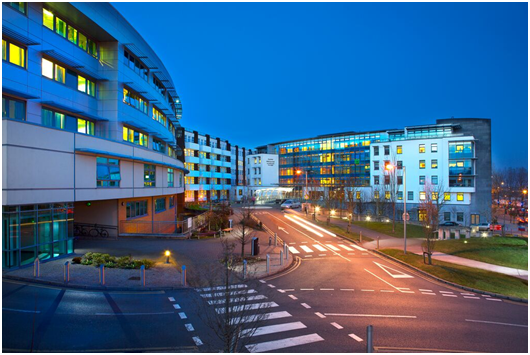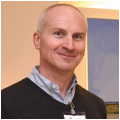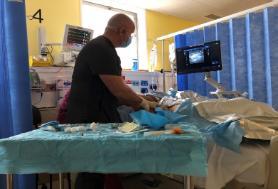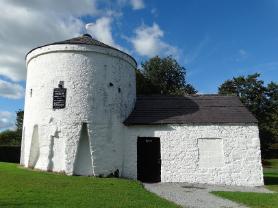The Anaesthesia newsletter May 2021

Dr Brian O’Brien, Chairman

Dear all, I’m grateful to Oonagh Hickey for the invitation to provide a departmental update for our website, and indeed, for her and Prof Shorten’s initiative in establishing and advancing the website itself. This is a difficult era for personal communication, and we grow ever more reliant on electronic means to keep in touch. Thus, further development of the website is timely. In any given year, with such a large team, there are inevitably defining experiences - successes and failures, moments, indeed, of triumph and despair. Some are collective phenomena, like the current pandemic, others individual, such as the births, deaths, and various career landmarks that punctuate our calendar. Every six-month term will involve cards or texts of condolence and congratulations, interspersed with exam dates, graduations and interviews.
The experience of Covid will probably remain a much larger landmark in all of our professional and personal lives – I suspect even decades hence we will recall whether any and every event occurred before or after the pandemic. It has been a time, in short, of unique public attention, of demand and stress for everyone in the business of anaesthesia and critical care. A time of looking at what we routinely do, but in a new light and with a fresh awareness of the associated risks and of the commitment required. I think it is fair to say that we performed very well indeed, with national outcomes for patients being better than many obvious comparators, social cohesion remaining strong and even a reasonable degree of regular and routine care continuing at hospital level. Locally the resilience of our team morale, their support and cooperation struck me as remarkable. I would pay particular credit to Mary Walsh and Murray Connolly for their wizardry in matching staff numbers to demand, and for numerous instances of insight and humanity along the way that allowed people even brief interludes to regroup, as necessary. A subgroup of particular note are those who commenced their careers in anaesthesia as the pandemic began. I had assumed many would drop out after a short time, as the awkwardness and difficulties of wearing protective equipment, and the associated risks, became evident. To my surprise it almost had the opposite effect - doctors from other specialties volunteered to help us when they were available, and some then chose to change fully to anaesthesia as the outbreak continued.
This illustrates what is perhaps the best aspect of medical life, that is the quality of the people with whom you work. While they are invariably of high ability and motivation, the encyclopaedic range of outside interests, broad cultural knowledge and our cosmopolitan backgrounds can combine to make the world seem small and comprehensible, and all problems local. The team often represents the globe in a microcosm. The immense challenges looming for India, for its doctors and healthcare system, will resonate deeply with many of our current and recent staff, and worry others as India may not be the last country to be so badly hit. It is probably true that any help a nation the size of Ireland can offer to India will be more symbolic than effective. Nonetheless, I was heartened to read that Ireland has sent some supplies there, primarily oxygen concentrators, and that the Indian ambassador, Sandeep Kumar, has gratefully acknowledged this gesture. There are estimated to be over 90,000 Indian citizens in Ireland, and their contribution to our healthcare and cultural life has been a significant one for generations. It is simply a pity Ireland cannot do more to repay the debt of that legacy at such a difficult time.
The social side of departmental life has been strained inevitably by the caution required to limit disease transmission. On Sunday last it was wonderful to join a group for the first such event we’ve done in some months. In perfect weather conditions, about 20 of us got out to cycle a loop of around 30 km around Cobh, incorporating a short break for coffee and a ferry journey which provided photo opportunities. Thanks to Frank and Caroline Loughnane for thinking laterally about how to arrange a day out, and for mapping a route that was challenging but just about within my capability! The fact that we are in the holy month of Ramadan probably limited numbers, and hopefully after or around Eid (in mid-May), we might be able to do something together again, be it similar or different.
A practical matter coming at us is the changeover in medical staff, and I know there are some within the team who have been unable to visit their family homes for a year or more. We may be stretched in another direction by people vacating posts early to travel to spend longer times with family therefore, or simply to travel due to wanderlust. There is a deep fatigue that many will want to shake off prior to July. As this pandemic began, I emphasised the importance of our own safety, and while there were cases of Covid and even of ICU admission within our number, thankfully no disasters have hit our frontline team members. I’d ask that we try to see out the term as much as we can, and also say, to those who are travelling, to remain cautious. The recent rate of change in Indian case numbers illustrates how hard in may be to plan confidently for the rest of this year.
I would hope that many will get to attend the CAI Congress, which will be a virtual event in 2021. I know a great many have submitted abstracts for it, and well done to them. Others will be on faculty for it, and thanks to Prof Shorten who had a major role in organizing the meeting. It represents the importance of maintaining training in this difficult time, a task our tutors and lecturer have managed well. The Congress also illustrates that we remain part of a bigger, national, and even global, network of colleagues who have dealt with the demands of the last year along with us, and who hope to learn all that can be gleaned from the experience. While I will miss the casual catch up that attending the meeting traditionally provided, it is important to support it so that it can emerge from these difficult times as strong as ever.
Thanks again for this opportunity and thank you to all members of the team for such professionalism and commitment in this last year.
DEPARTMENTAL UPDATES:
We are delighted to announce that we now have three fellowships which provide higher specialist training in trauma and regional anaesthesia. Joining us in July are Dr Murray Connolly and Dr Litsa Serchan (who is returning to us from Greece). Dr Agatha Biculescu will continue in the third PNB fellow role supporting ambulatory hand trauma and commencing a regional anaesthesia education programme with ED trainees.
We also aim to introduce a new tier of call to address the expanding complexity of the services provided by our Department.
The Department would like to thank Ms Aoife Walsh and all those on the DePuy Synthes Cork Corporate Social Responsibility and Facilities Team for the very thoughtful Johnson and Johnson care packs, given in recognition of the hard work of all members of the Department during the pandemic. These were kindly sent to Dr Sean Farrelly- they were swiftly distributed and greatly appreciated.
GOOD NEWS:
 |
|---|
Dr Claire Healy, Senior House Officer
In March Dr Sarah Ryan gave birth to a baby girl named Aoife.
In April Dr Ciara Fahy and her husband (and our previous colleague) Dr Ronan Bluett welcomed a baby boy named Tom.
After a long lockdown, Dr Orna Ní Choileáin’s wedding dress still fits, and so her July nuptials are full steam ahead!
ACADEMIC NOTES:
November 2020. The pandemic has posed particular challenges for clinical teaching of medical students. Corina Soare and colleagues have begun to explore the potential of mixed reality using the Microsoft Hololens for fourth year students at UCC. https://bmjopen.bmj.com/content/10/11/e042378.responses#hololens-and-clinical-teaching-during-the-covid-19-pandemic-
March 2021. Dr Hassan Ahmed and colleagues describe two (separate) cases in BMJ Case Reports which he encountered during his term as PNB Fellow at CUH. The first details anaesthetic management of patient with eosinophilic granulomatosis with polyangiitis who underwent internal fixation of a fractured femur. Anaesthetic management of a patient with eosinophilic granulomatosis with polyangiitis for internal fixation of a fractured femur. Mohamed H, Ce Ó Mathúna E, Elbardesy H, Shorten G. BMJ Case Rep. 2021 Jan 8;14(1):e239052.
 |
|---|
The second teases out the diagnostic dilemma which can occur following traumatic brain injury in distinguishing salt wasting nephropathy from SiADH. Distinguishing cerebral salt wasting syndrome and syndrome of inappropriate ADH in a patient with traumatic brain injury. Mohamed H, Shorten G.BMJ Case Rep. 2021 Mar 10;14(3):e237027.
April 2021. Dr Fahd Aamir and colleagues published work carried out during his time as Lecturer in The Dept of Anaesthesia, CUH. A sono-anatomical and cadaveric study of ultrasound-guided retrolaminar block. Fahd Aamir, Michael Cronin, Peter Lee, Gabriella Iohom, George Shorten. Med Ultrason. 2021 Apr 22. doi: 10.11152/mu-2979.
 |
|---|
Retrolaminar block is known to confer chest wall analgesia but, its mechanism has not been established. The primary objective of Fahd’s work was to determine if the spread of injectate following RB extends to the paravertebral space (PVS). Secondary objectives were to determine the predefined anatomical areas and nervous tissues contacted by injectate; the effect of volume on spread; and the extent to which experts can predict PVS spread based on examination of US videos of the injection.
The investigators concluded that injectate spread following retrolaminar block demonstrated substantial variability. Inconsistent spread to the ipsilateral PVS may account for clinically occurring incomplete blocks. The likelihood of spread to the ipsilateral PVS was greater when a larger volume was injected. Expert evaluation of the dynamic ultrasound images obtained at injection can-not reliably predict spread to the PVS.
May 2021 . Distinguished intensivist and academic Dr Martin Tobin will deliver the inaugural Brian Kavanagh Lecture at CAI Congress 2021. https://www.anaesthesia.ie/education-events/annual-congress/
 |
|---|
The Lecture honours the late Dr Kavanagh whose obituary in Critical Care states: “Critical care lost a scientific giant and a treasured colleague and friend when Brian Kavanagh passed away on June 15, 2019 at the age of 57. He was brilliant, complicated, and revered by patients and their families, as well as students and colleagues around the world”.
Dr Tobin has generously shared his lecture (originally presented at SMART Conference Milan) on the decision and timing of tracheal intubation for patients with Covid 19 lung disease. It is characteristically thought provoking and insightful.
https://drive.google.com/file/d/1BXb4XOcCwmpC_8pjOk6Fw-CwetQYH4fX/view?usp=sharing
SPOTLIGHT SECTION:
Hip fracture and the anaesthetist.
Dr Brian O’Donnell, Consultant Anaesthetist
 |
|---|
Hip fracture is a common and extremely painful injury in older adults, requiring urgent surgery to fix the fracture and regain independent mobility. These patients often have complex medical problems and achieving the best possible outcomes require the collaboration of anaesthesiologists, orthogeriatricians, orthopaedic surgeons, specialist nurses, physiotherapists, occupational therapists and clinical nutritionists.
Our dedicated team of anaesthesiologists are part of a multidisciplinary team, and we have developed and implemented best practice standards within the operating theatre and beyond. We employ regional anaesthesia to facilitate surgery and to complement traditional pain relief medicines in the management of postoperative pain. High quality pain relief assists quick recovery and excellent rehabilitation.
We aim to fix patients fractures at the earliest possible opportunity and operating lists are run efficiently in collaboration with theatre nurses and surgeons. Attention to detail ensures that the simple things are done well. Enhanced monitoring and careful control of blood pressure are vital during surgery. Spinal anaesthesia avoids unnecessary unconsciousness and avoids complications such as pneumonia.
Cork University Hospital manages over 530 patients with hip fractures each year and our clinical outcomes are amongst the best in Ireland. This allows us to transition patients effectively away from the acute hospital toward rehabilitation, convalescence, and discharge home. Our effective multidisciplinary team and the approach to patient care means that in CUH patients spend 4.5 days less in hospital than in other hospitals in Ireland. Our trauma anaesthesiologists and the use of effective regional analgesia are key enablers of quality patient outcomes.
DEPARTMENTAL ACTIVITIES:
Departmental cycle to Cobh
Dr Frank Loughnane, Consultant Anaesthetist
 |
|---|
Our most recent department activity on April 25 was a cycle trip from Rochestown to Cobh via the Passage West ferry taking in the Rochestown to Passage greenway. Once on to Cobh Island, we headed north to Belvelly and then east toward Marlogue before dropping down into Cobh town. Although blessed with glorious sunshine the cool easterly wind meant nobody availed of the opportunity for a swim at Cuskinny Beach on this occasion. There were plenty of takers for coffee and some serious chocolate and raspberry brownies on arrival in Cobh> A very pleasant hour was spent at the bandstand overlooking the harbour and the wooden pier where passengers boarded the tenders which took them out to the Titanic. Modern cruise liners continue to plough their trade in Cork Harbour. A pleasant and sedate leg home with a nice breeze to our backs had everyone home in time for a late lunch.
RAMADAN:
Dr Ashfaq Alfridi, Anaesthetic Registrar
Ramadan is the ninth month of the lunar Islamic calendar. Ramadan is also known as the Month of Quran, the holy book of Muslims sent to all mankind.
During this month, Muslims fast from dawn to dusk. Fast entails no food or drink. Ramadan is a time of increased worship, self-awareness and reward.
Allah or God wants His followers to be successful by living a God conscious life, a life lived with such cognisance that he/she is under God's merciful, watchful eye. To reach this state, He has laid out for them a blueprint through His Book, the Quran, and the words and actions of His Messenger (pbuh). The major aim of fasting is to achieve God consciousness, the key concept and attitude from which all goodness’s emerge. The essence of God consciousness is to leave impermissible actions. As a prophetic saying beautifully goes: "whoever does not leave evil words and deeds while fasting, Allah does not need him to leave food and drink.”
After a month of hard work, a gift is awaiting in the form of Eid ul Fitr. Eid is an occasion of rejoicing and a new start.
LOCAL INTEREST:
The Ballincollig Royal Gunpowder Mill
Dr Oonagh Hickey, Consultant Anaesthetist
Many of our Department utilise the lovely Ballincollig Regional Park- to exercise, to walk the dogs and to bring the kids to the playground. A few people have asked me about the ruined buildings and canals. Opened in 1798, the Ballincollig Royal Gunpowder Mill became the second largest gun powder mill in the British Isles during the Napoleonic Wars, utilising over 20 waterwheels. It brought great prosperity to the area, directly employing 500 people. The gunpowder produced was used by the British Army but also for quarrying and for building railways.
 |
|---|
A high perimeter wall and watchtowers (photo) were built to protect the mill, and a British Military Barracks was built nearby. Gunpowder was transported to Cork Harbour under military escort and one such transport in 1803 left a trail of gunpowder down Washington Street. It was ignited by a spark from a boot, much to the consternation of passers-by.
Occasional fatal accidents occurred at the mill, but the largest loss of life occurred near St Finbarre’s Cathedral in Cork City on Brandy Lane (named because of the practise of fortifying condemned prisoners with a glass of brandy on their last walk to the nearby public gallows). In 1810 Thomas Ellard, an employee of the mill, stole up to half a tonne of gunpowder with a view to selling it to local quarry men. On 3rd November, the gunpowder was drying next to a candle when it exploded, killing 22 people and injuring 40.
The mill finally closed in 1903. Many of the buildings and high walls are still visible in and around Ballincollig Regional Park, and occasionally flooding of the nearby River Lee brings life back into the canal system. Cork County Council has developed a downloadable “Ballincollig Gunpowder Trails” leaflet and a map of suggested walks in the area.
